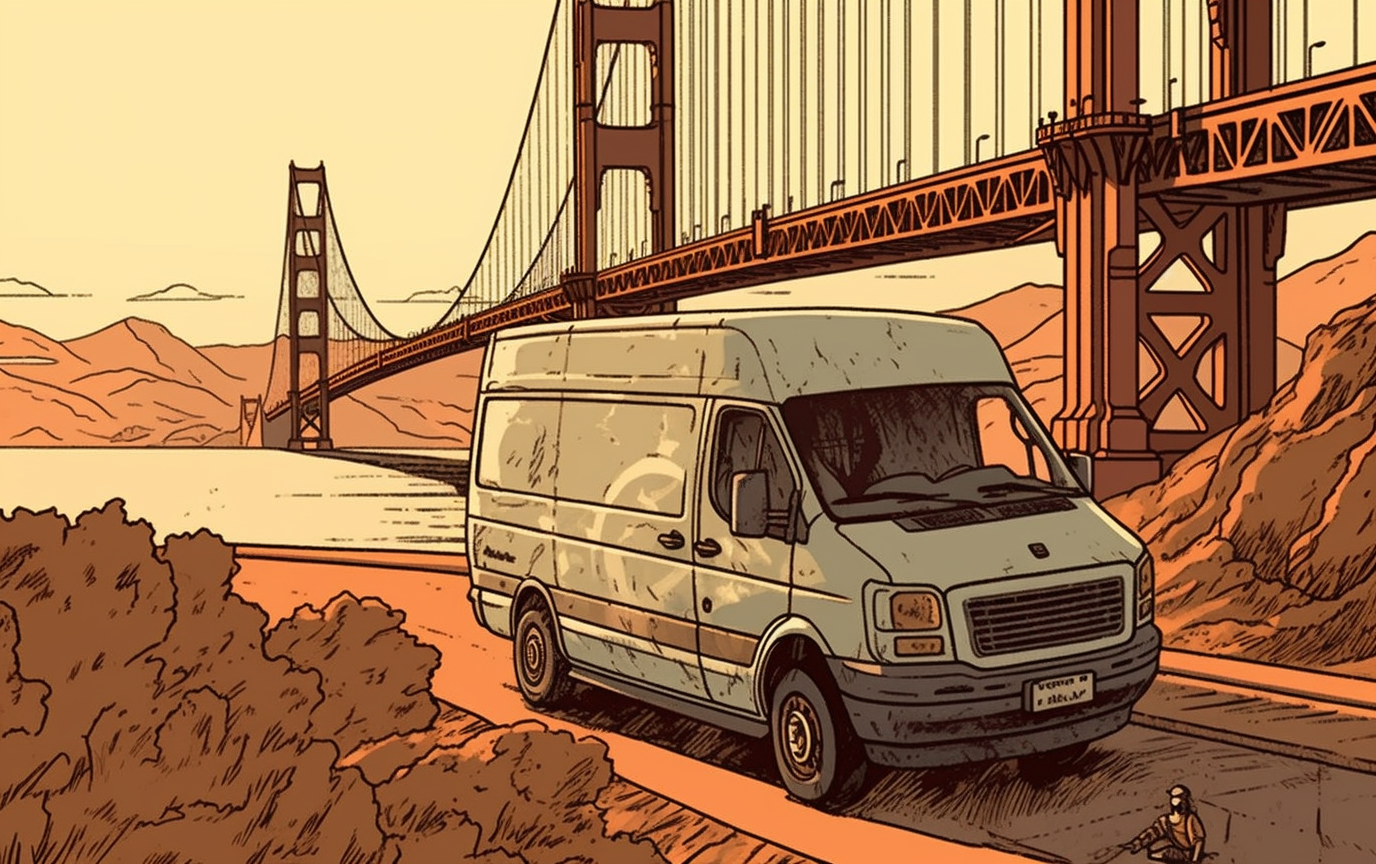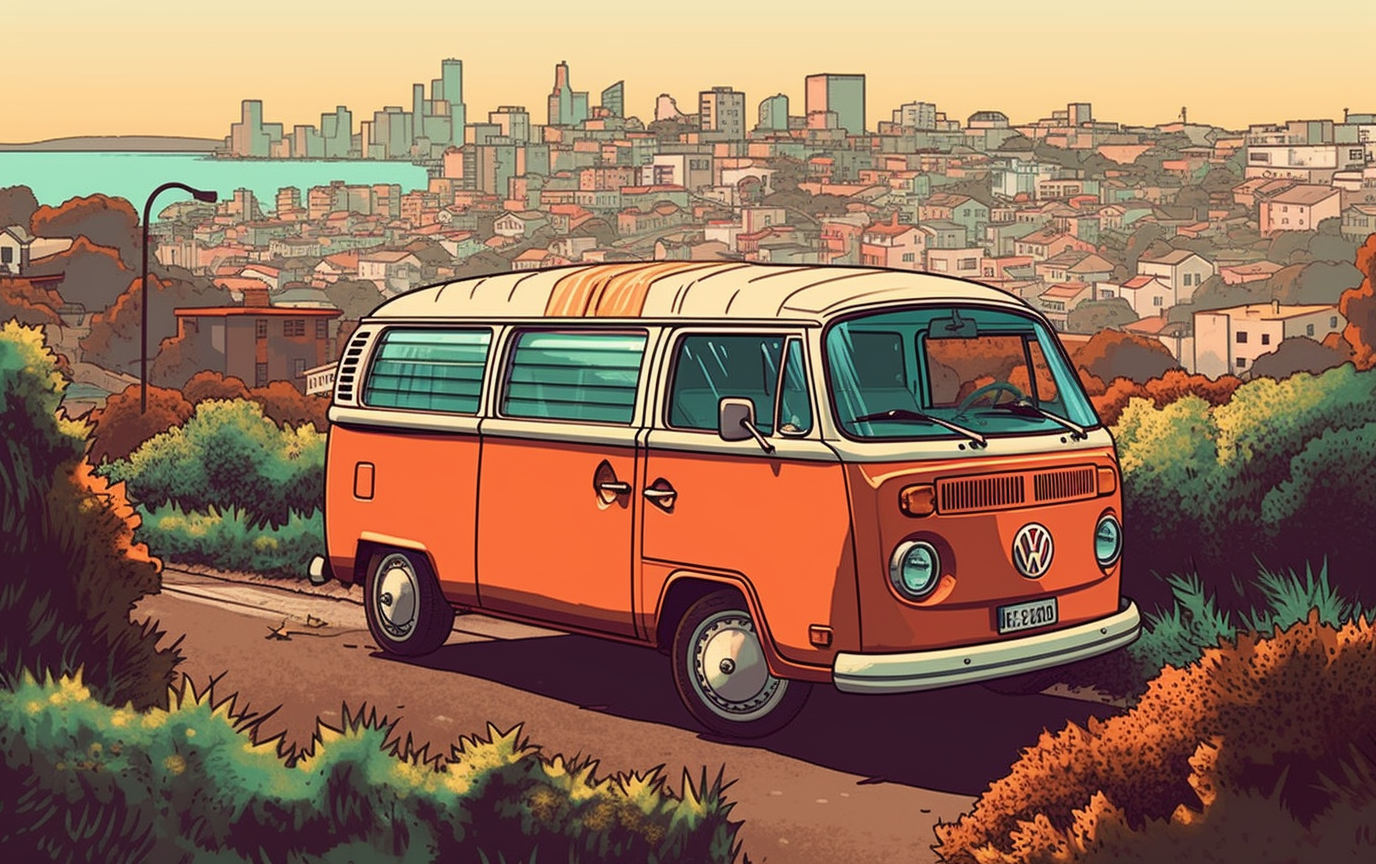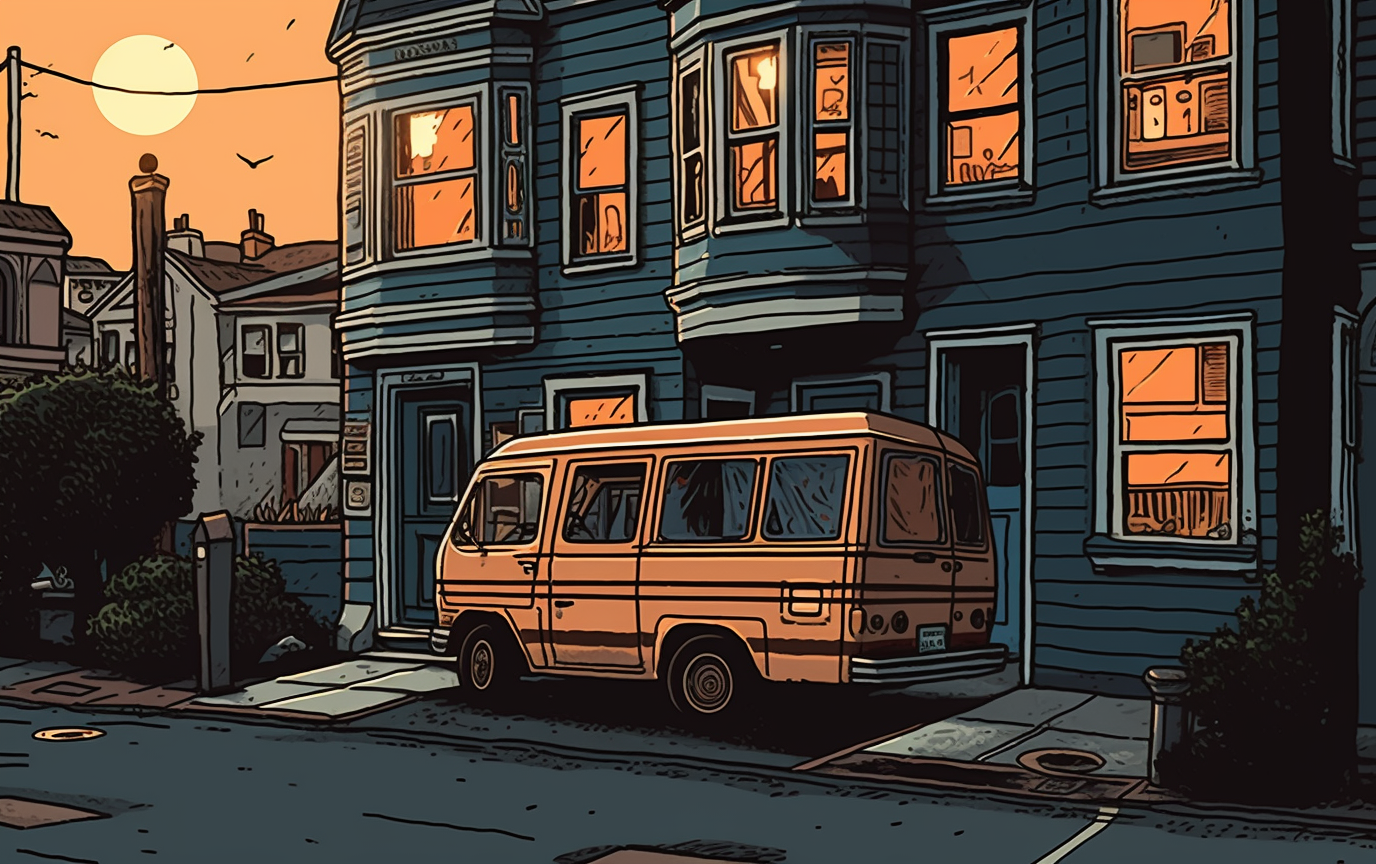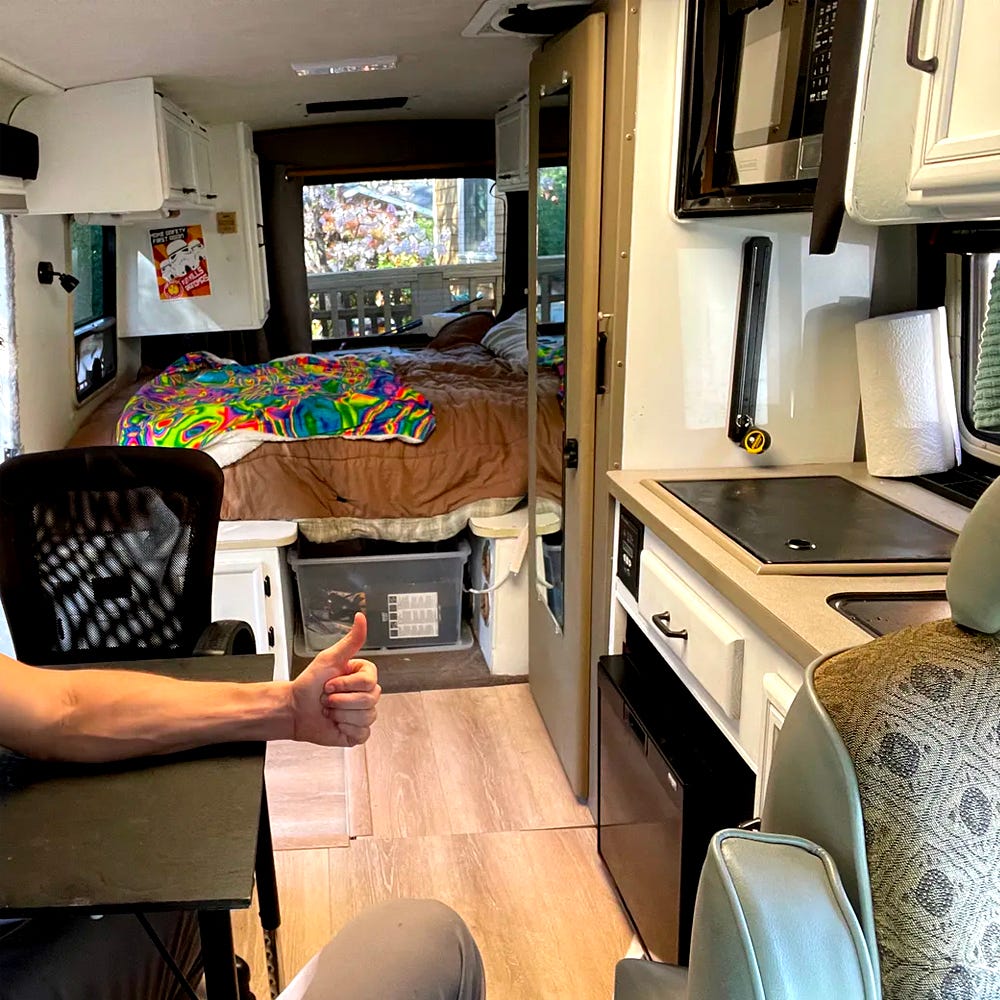This story is part of a series detailing what it’s like to live in a van. Part I is about the author, Corey, restoring his Winnebago. To protect his anonymity, exterior photos and illustrations in this article are not of his van.
My home of the last year has been my hand-renovated 1996 Winnebago affectionately named ‘Armin the Van Yourein’, parked by choice on the streets of San Francisco. The urban “#VanLife” lifestyle is definitely not for everyone, but it suits me well. It’s been a lifelong dream, though the reality never matches the imagination.
I want to share the reality of urban vanlife for others who may be curious. I’ll answer the questions that everyone asks and also cover the upsides and downsides. Then I’ll dive into the politics.
What everyone asks me:

“Where do you park?”
I park my van on the street in a formerly industrial part of town, and move it twice a week for street cleaning. There are other vans nearby, as well as pedestrian traffic and cafes.
This location is what makes the lifestyle work — it’s flat, quiet, safe, and central. Without a location like this, vanlife would be a lot harsher. Having to relocate every day to find a place to sleep doesn’t sound fun.
That said, I’m sure one can find spaces like this in most cities and neighborhoods if they know where to look.
“Where do you take showers and laundry?”
I shower at a nearby gym, use my van’s bathroom and kitchen, a laundromat for laundry, and work at a co-working space biking distance away. I get my mail delivered to the co-working space.
“What about waste?”
I trash, recycle, and even compost using the grocery store and gym’s available containers (thank you, San Francisco!).
It feels great to have a closed system, where the waste from my purchases go right back where I bought it from. Reminds me of systems in Germany and elsewhere that require grocery stores to also be recycling centers to take in the waste from the items they sell.
Once a month I drive to an RV dump site 30 minutes away to empty my tanks and fill my propane and water for $25. Not a bad utility bill.

“What about dating?”
The women I’m interested in, almost by definition, don’t mind my vanlife. If you’re interested in vanlife, chances are your partners won’t mind either.
Throughout this year I’ve slept at my partners house maybe twice a week average, and gratefully stayed there while my van was in the shop. Sometimes she’ll stay over in the van when it makes sense. I have a queen bed, after all.
“Is it safe?”
In this entire year, nobody has bothered me or my van even once — in car theft heavy San Francisco! I assume that vans don’t get broken into because thieves don’t know if you’re inside them.
Plus my van is old and janky on the outside, which make it look like a vehicle you probably don’t want to mess with. My neighbor has a decked out Sprinter van with security cameras on the roof, and it’s been broken into twice.
“Have you taken it on any trips yet?”
No, I haven’t taken it anywhere beyond festivals and camping weekenders, where it certainly shines. It’s fun not to have to pack before leaving.
Having my own bathroom, kitchen, and cozy sun drenched bed rather than a tent is a huge game changer. Festivals still charge you the same cost you paid for your ticket to bring it onsite, so it’s not like you’re saving money. But you are saving comfort.
All my friends are in San Francisco, so I enjoy having the stability and the routine. It feels like I’m backpacking sometimes, but I still have all my stuff and my own bed. The videos I’ve seen online of long van trips look rather lonely, to be honest. But if the stars align, I certainly will take Armin somewhere.
A cool startup that addresses the vanlife loneliness issue is Kift, which has properties around the West Coast you can park and hang out with other vanlifers.

“… But why?”
I don’t have a good answer to that one, other than, ‘Why not?’ I’ve been a lifelong minimalist, nomad, and spendthrift, so maybe this is the logical conclusion. It’s something I’ve always wanted to try, and I’ve seen friends and bloggers like Tynan do it in this exact model, so it was a matter of time.
Needless to say, I view it as a phase of my life and not the end state. And I’m enjoying the ride! I thought I’d like it, and I was right.
Why San Francisco is perfect for van living:

Vanlife works well in San Francisco because the house life often doesn’t.
In my van, I face doorstep feces, street noise, and poor heating insulation. But I also faced all of those in the fancy old Victorian I lived at in the Haight.
Viewed along square footage and amenity dimensions, the way I’m living is not that different to the way many city folks are living under actual roofs.
Vanlife works well in SF because of rent prices. (Duh.)
I paid $1,800 in rent alone previously, and now my total fixed monthly costs are around $800 — that includes groceries, co-working membership, insurance, and the gym.
I have friends who left the Bay for cheaper places like Denver, Austin, and Ashville but complain about their social lives being smaller — meanwhile I just moved to the street and live the same Bay life.
It feels great to reinvest rent money into things I care more about, like events, classes, and travel. Put simply, I’m skimping on an unimportant expense (rent for a ‘real house’), to splurge on things I care about (quality of life charges).
Now, if I was driving often, that might catch up real fast. At a conservative ten miles per gallon and gas at 6 dollars a gallon, I’d have to drive around 2,000 miles per month in order to match my previous rent expenditure. But that’s almost across the entire United States — so it’s unlikely I’d get that far in a month repeatedly.
San Francisco weather is also great for vans.
It’s never below freezing, and it hardly ever gets crazy hot.
That said, there are vanlifers all over North America, if you ramp up your van engineering to match the needs. Check out all the vanlife Youtubers in the Midwest, for instance.
The downsides:

Dependable sleep
The biggest downside is the street noise. As I said, my street is relatively quiet, but you can still hear cars and people going by. I hear of people who have insulated their vans for warmth and sound better, but I also hear that even the best retrofitted vans still have sound leakage.
As a result, I don’t have full control over my sleep schedules. I often get woken up when a giant truck goes by or some construction starts. It’s not ideal, but my sleep app says I’m still sleeping well, and I still get 9 hours with some help from melatonin.
Laundromats
The other biggest shift for me has been the laundromat experience, coming from in-unit machines previously. Going somewhere, then waiting for half an hour, then coming back, then waiting another 45 minutes easily eats up 2 hours of your week.
And yet many people live this life normally in homes without laundry machines — wow! I try to bundle it with other errands to make it a ritual.

Office work
Here’s a downside that is only true for me coming from years of working remotely from home. Having to go to an office!
Bringing food in, commuting both ways, remembering what items are where, etc etc. At least I don’t have the office politics in my coworking space. Yes, I could work from my van, but that’s an unnecessary hassle in my mind.
For office workers who already spend big chunks of their days outside the home, this lifestyle makes even more sense, and wouldn’t change much of your reality.
The politics of vanlife:

There are many political dimensions that come from vanlife. I hadn’t expected confronting them myself, but they become more visible once you move in.
One might say, “Come for the rent savings, stay to own an affordable home and exist outside of the rat race.”
The vanlife you don’t see on Instagram hashtags is a great option for people down on their luck, or who just don’t want to pay to exist on Earth. Indeed, those living the vanlife by necessity and not by choice like me exemplify this.
Progressive causes champion rent control and bemoan a NIMBY-ism lack of affordable housing — both of those are solved for in my current life. Millennials dream of going back to the land in rural communes but lack the architecture for it — parking several of these vans next to each other is a great bootstrapped solution.
Plus, given San Francisco’s large unhoused population, the laws here forbid towing a vehicle that appears to be used as shelter. There’s no doubt that helps explain why I haven’t been bothered in the last year, and more so given that my van doesn’t leak anything and parks legally.
Again, you could get away with this in other cities with a stealthier build or by having friends with parking permits — just is to say, it’s easier here.
Vanlife, therefore, is a shortcut to the utopian future many dream of, where rent is free and we don’t have to fill our time with labor for basic survival. Usually the dream comes with travel and nature, but I’m here to say that life on the street doesn’t have to mean life on the road. I am consistently amazed by how good my vanlife is, and how similar it is to my old life in a house.
For everyone like me, there is another who would hate vanlife (and I see it in their visceral reactions when I mention it, lol). But I think there are more of us than we realize.
Maybe you’re one of them.
Corey is a recovering startup founder living in a van. Follow him on his Substack.







